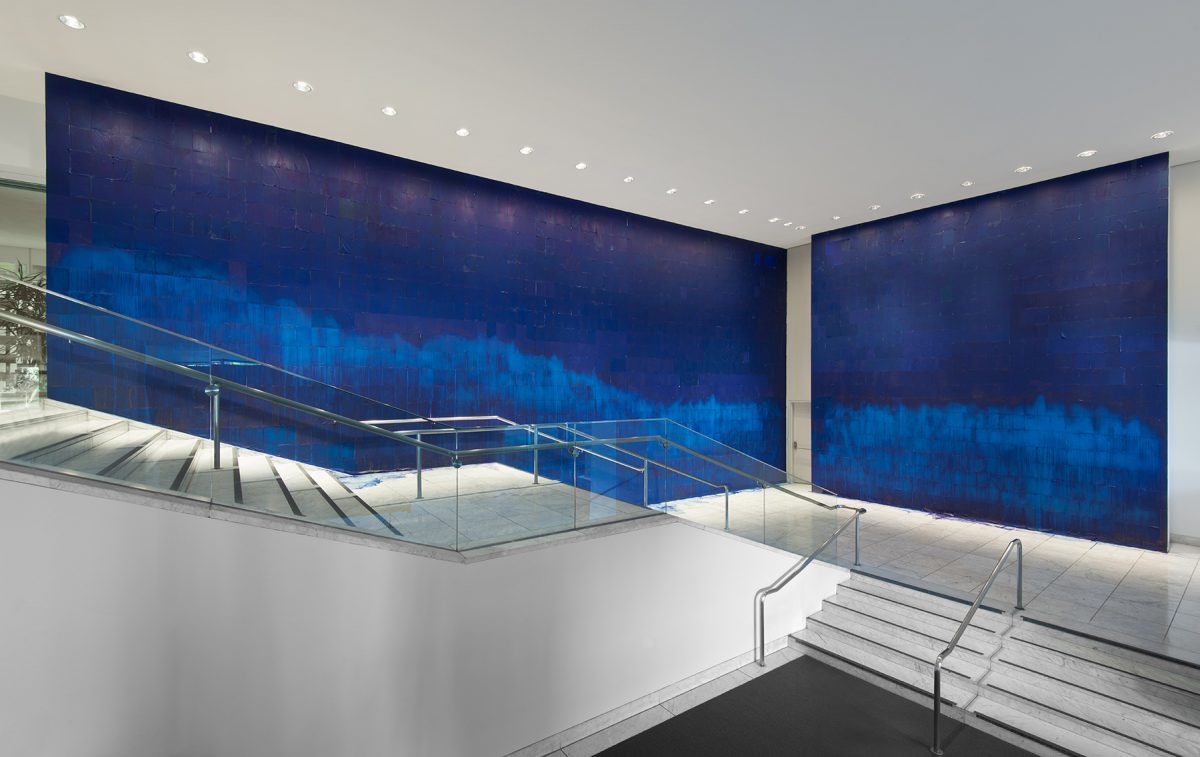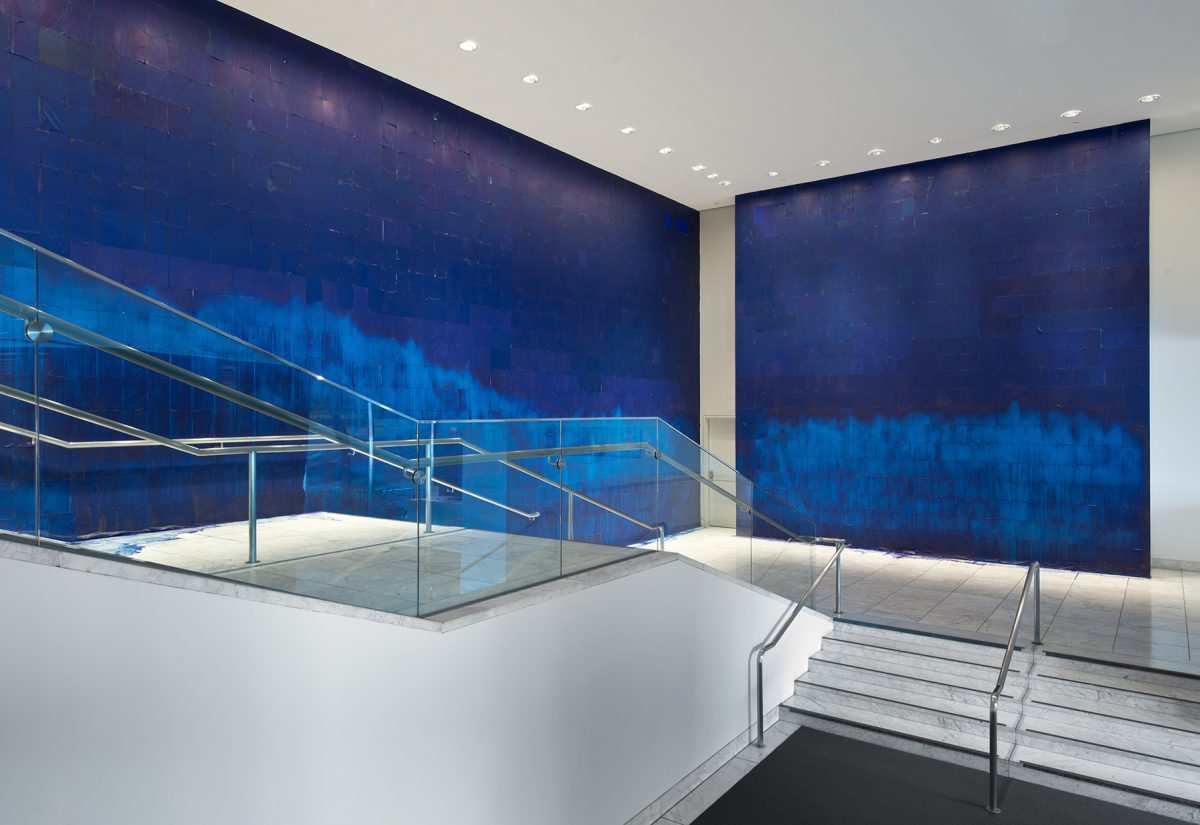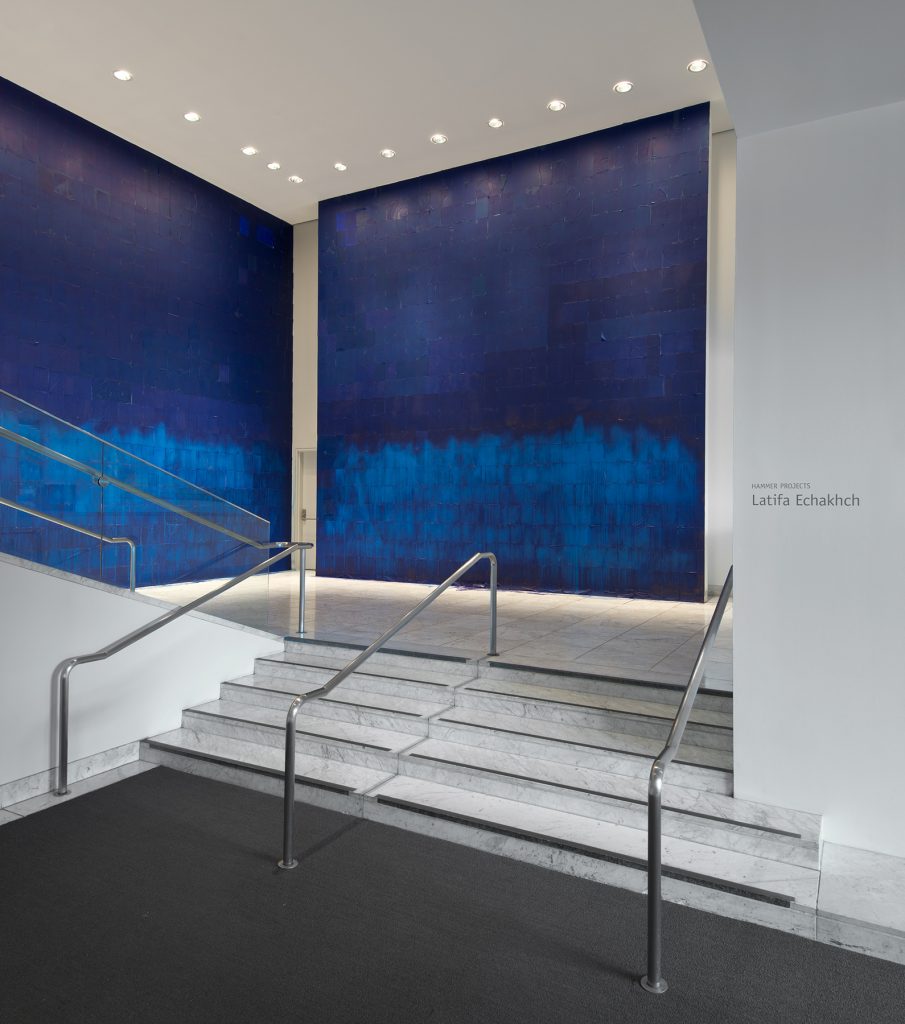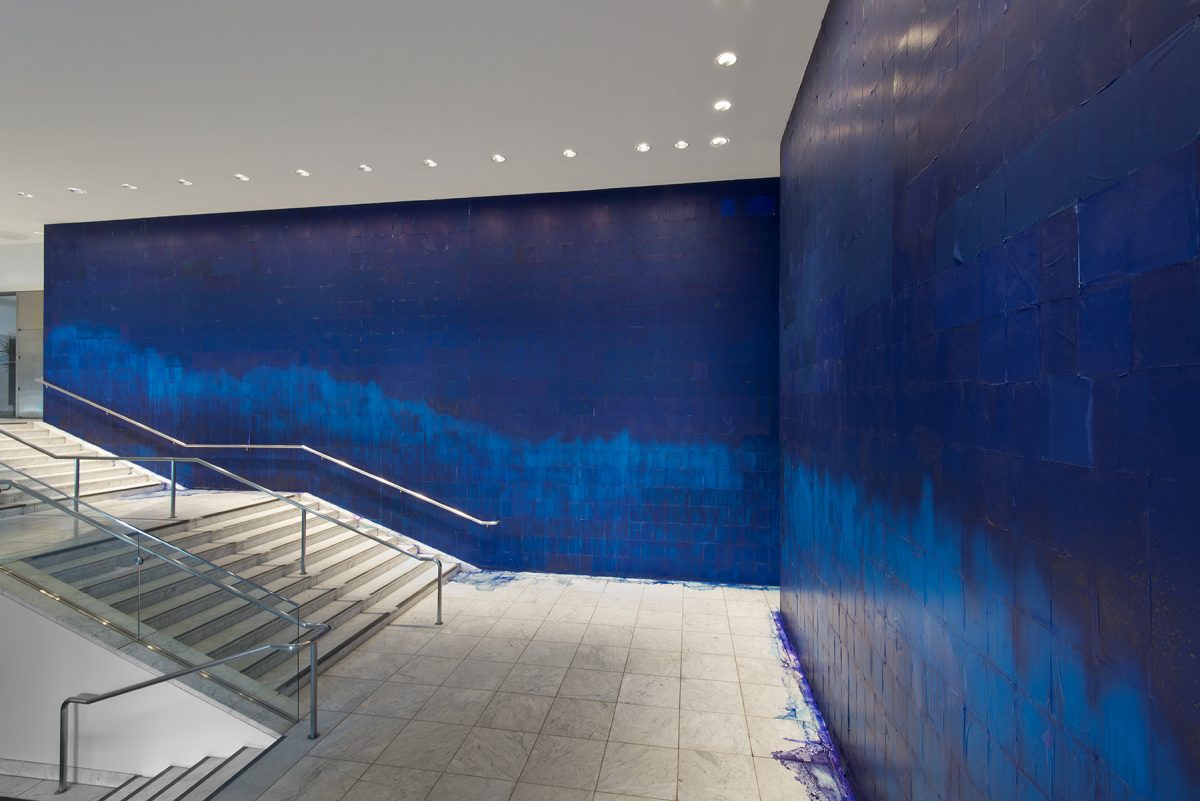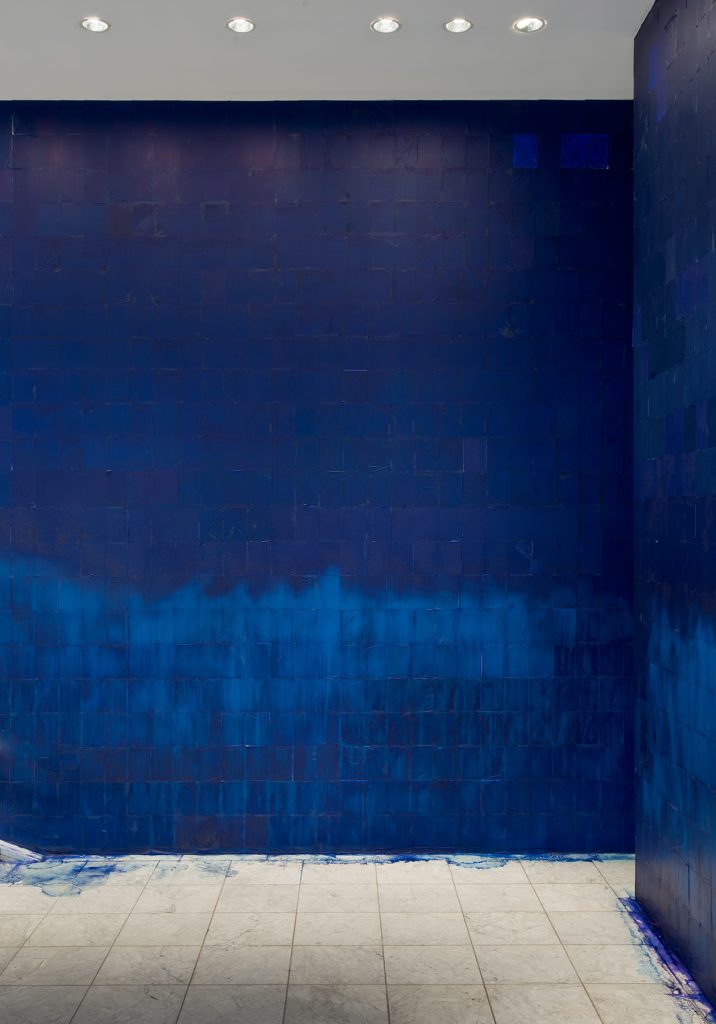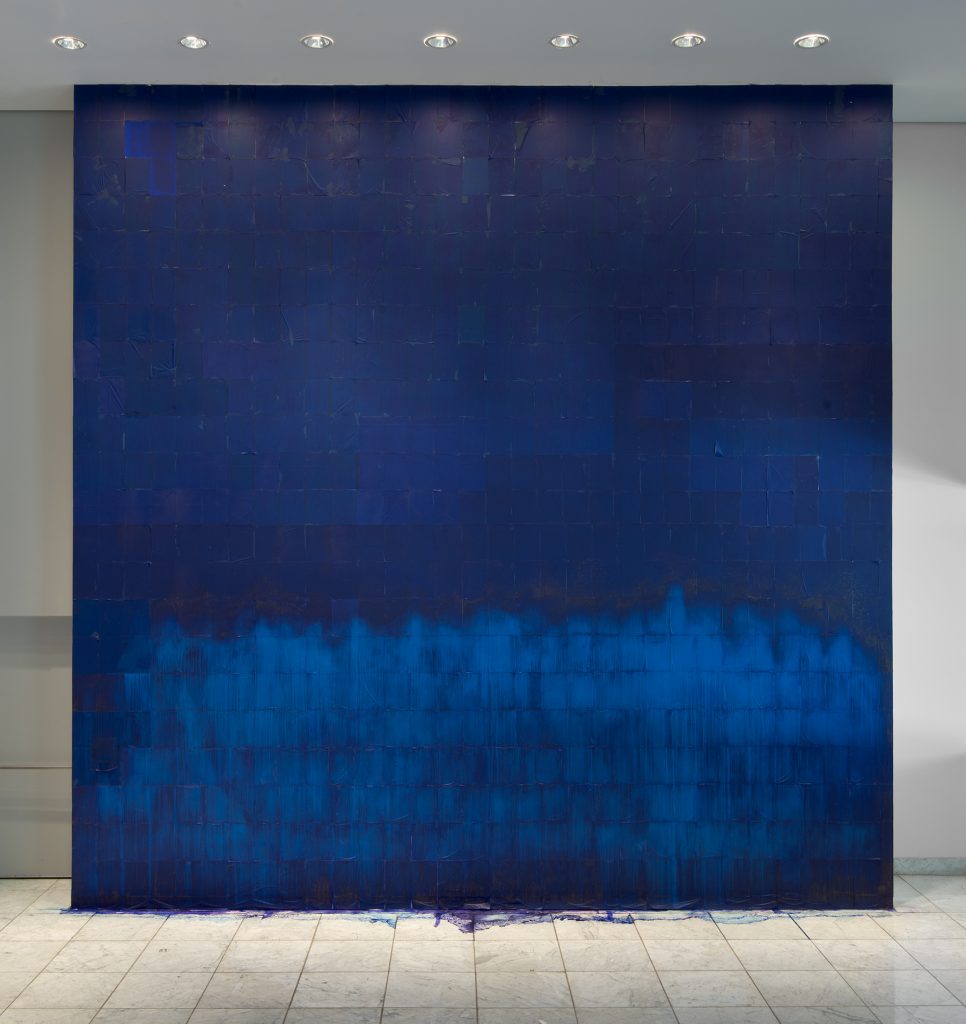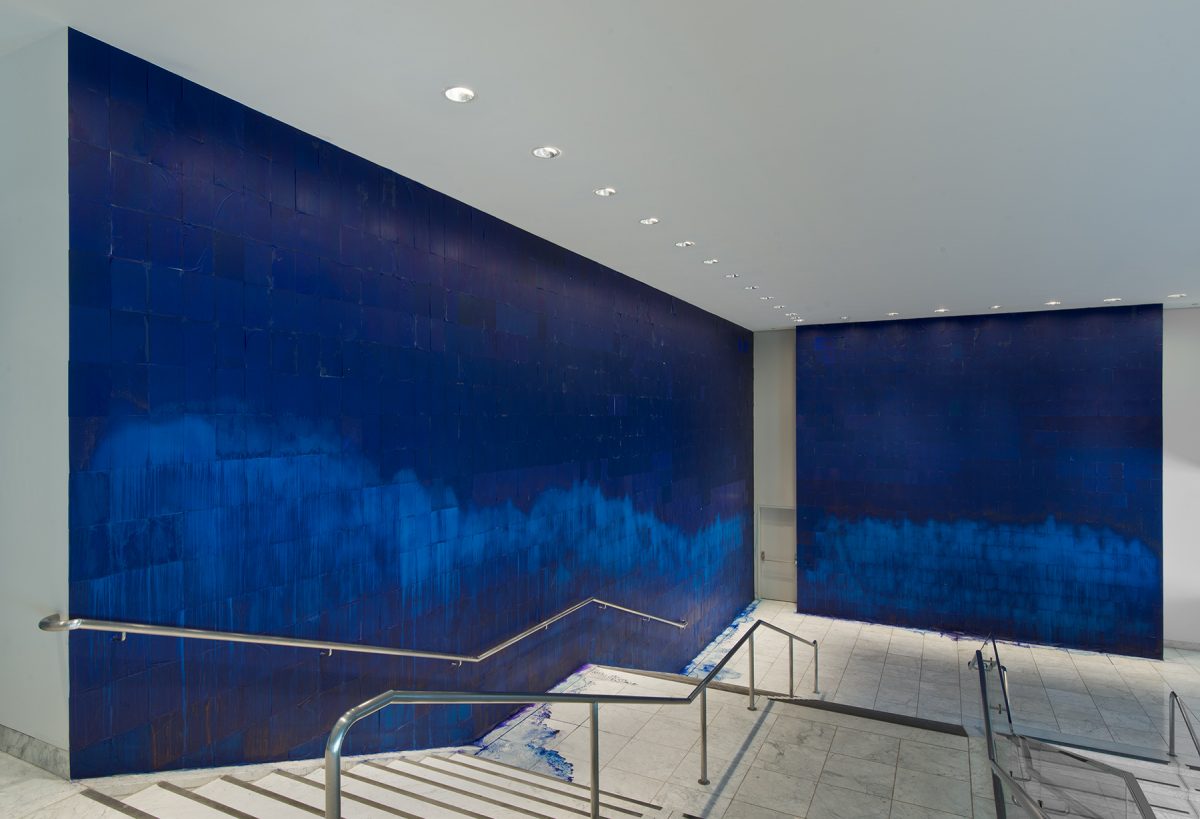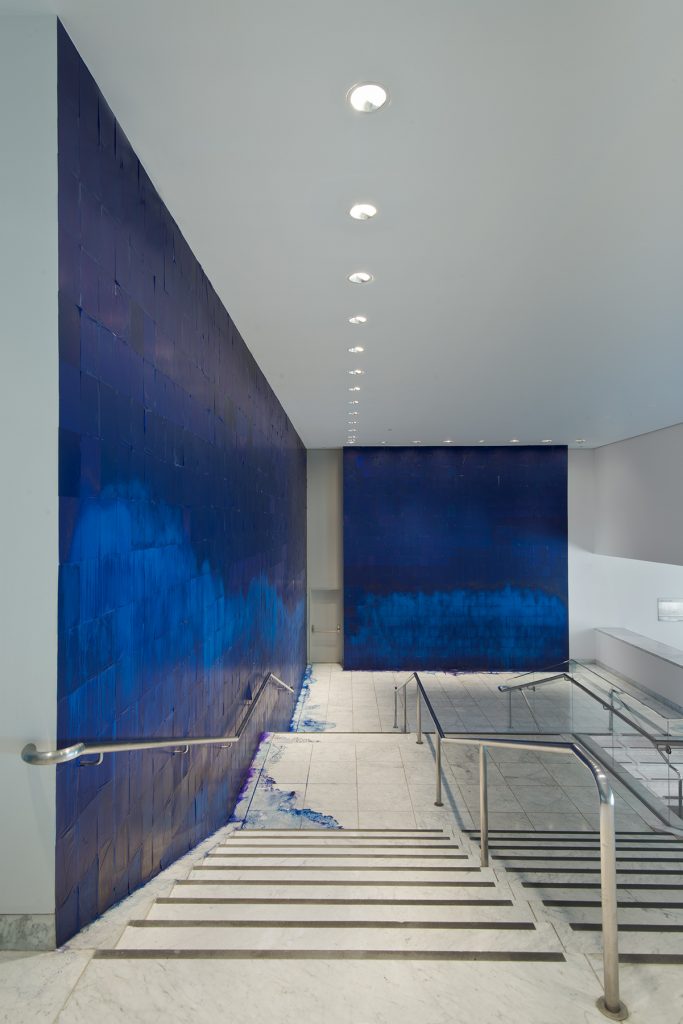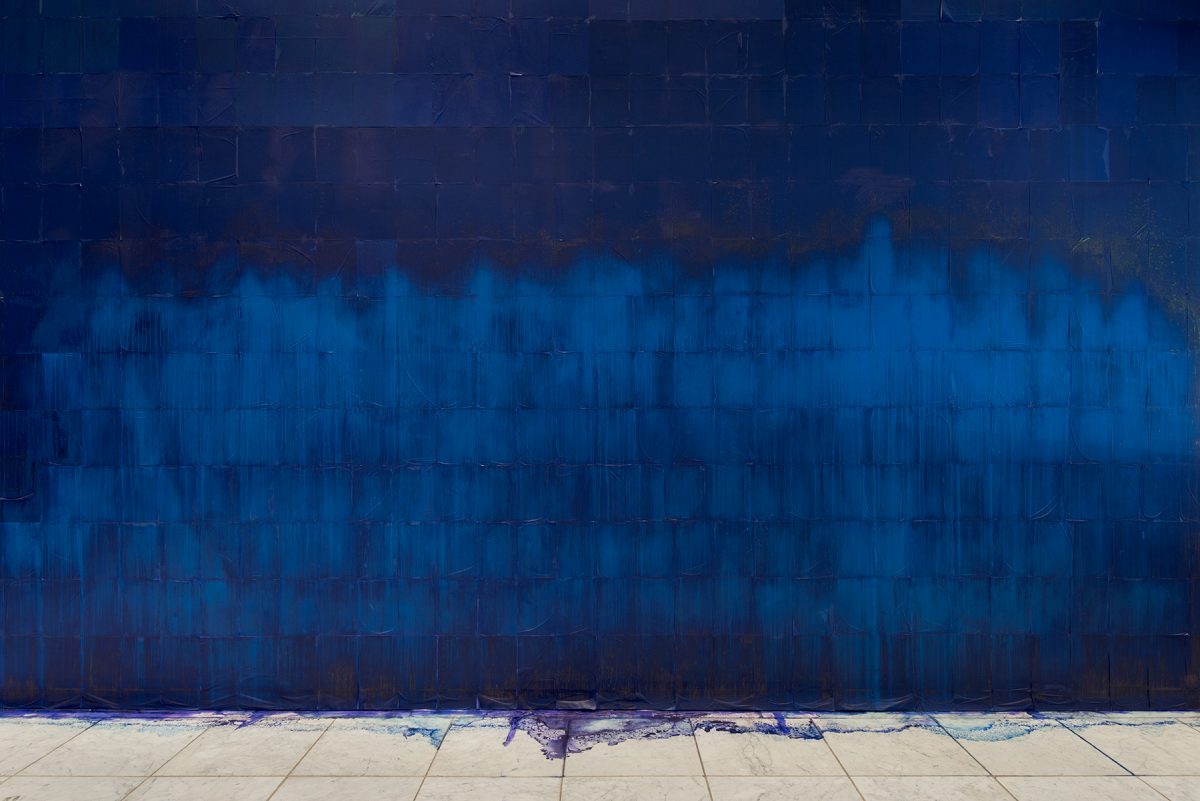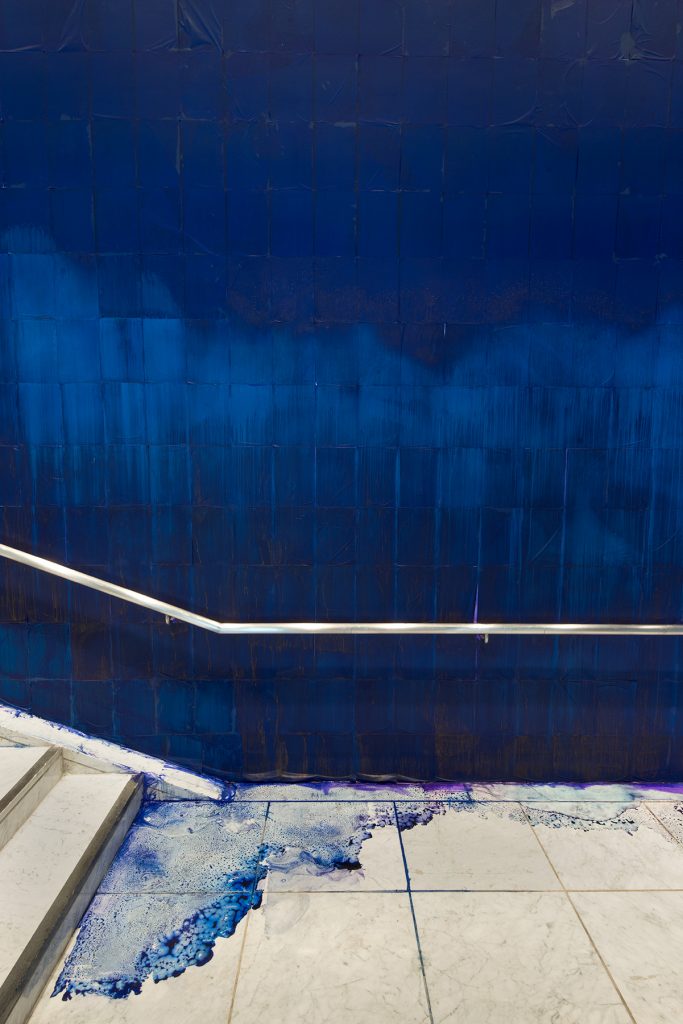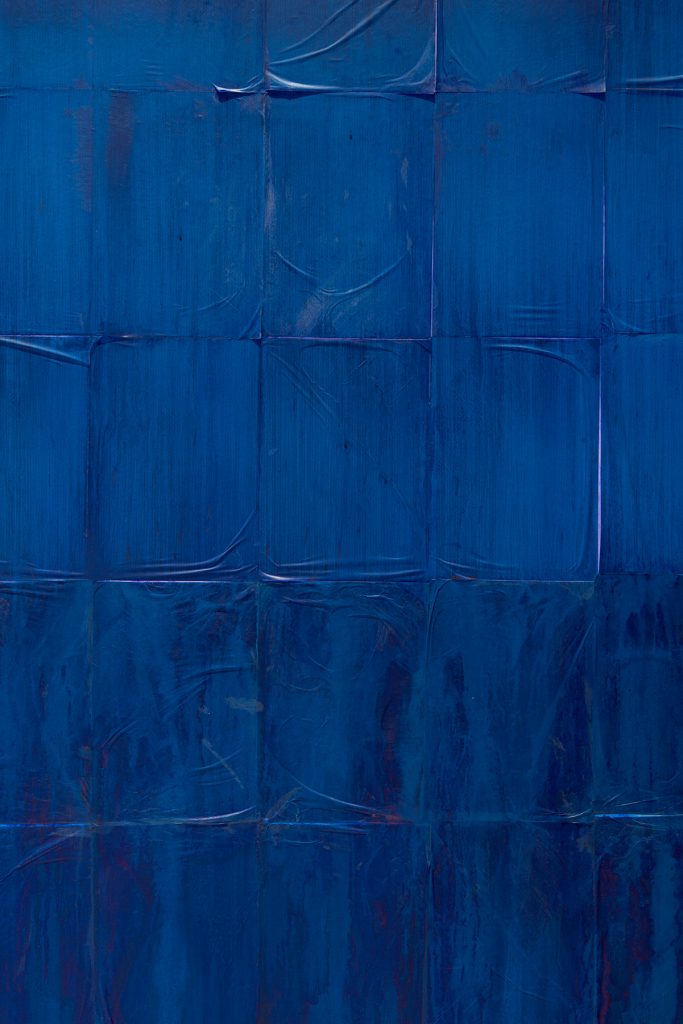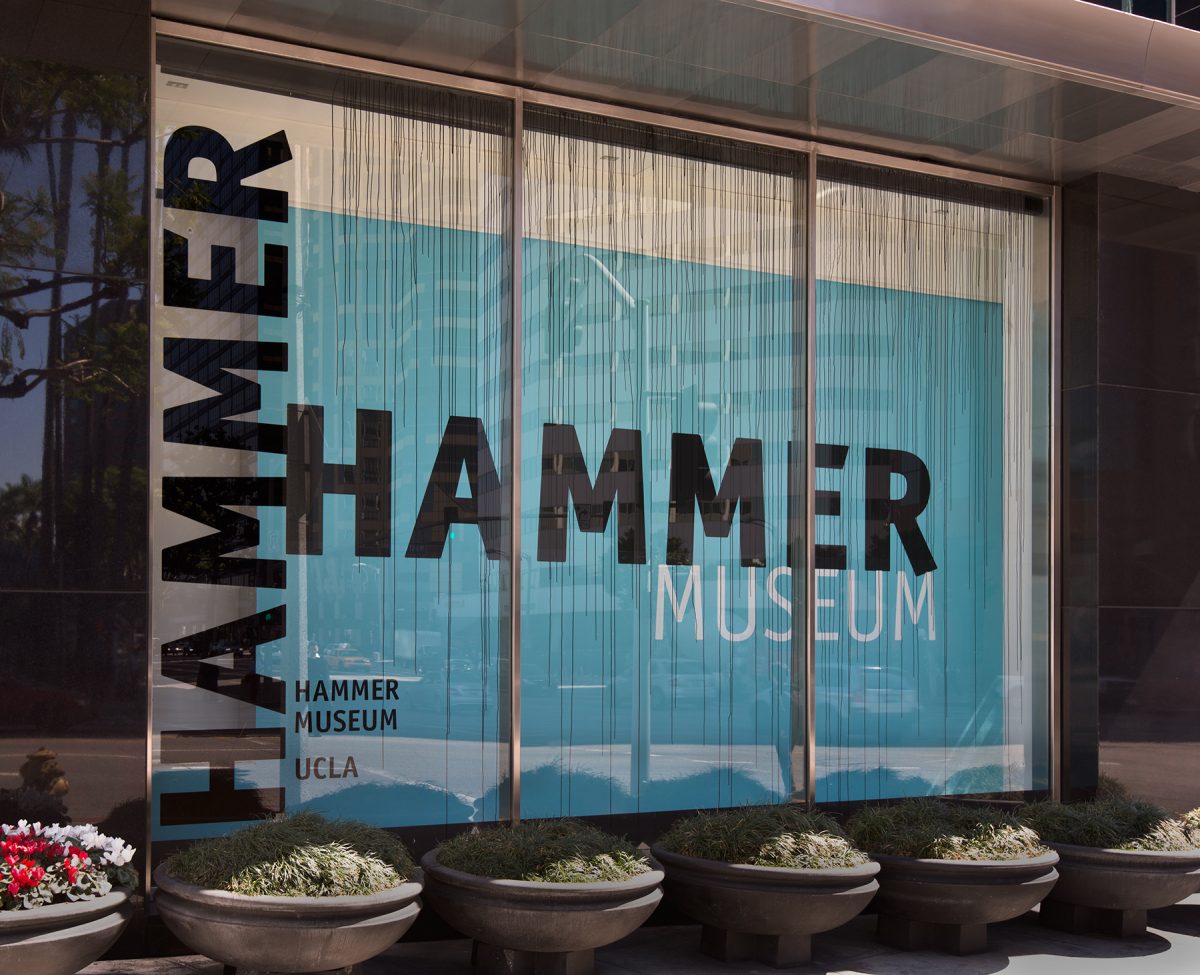
- This event has passed.
HAMMER PROJECT
For her Hammer Project, Latifa Echakhch reprised her 2007 work À chaque stencil une revolution (For each stencil a revolution) for the Hammer’s lobby wall. After attaching hundreds of sheets of carbon paper to the wall, Echakhch treated the surface with a solvent that causes the ink to run down the pages and pool on the floor. her use of carbon paper points to an outmoded duplication technology that was central to the ability of political groups of earlier generations—such as the civil rights and anti–Vietnam war protests of the 1960s-to disseminate information and opinions. The title of the work is a quotation from the Palestinian leader Yasser Arafat who was referring to the proliferation of revolutionary groups and protest movements. while the work pays homage to the uprisings of that period, it rings with melancholy: stripped of its ink, the paper is robbed of its potential to carry any message. Referring as well to both abstract expressionism and the signature blue of Yves Klein, the work asks us to reconsider the relationship of abstract art to politics. Hammer Projects: Latifa Echakhch is organized by Hammer senior curator Anne Ellegood.
Today revolutions are fought as never before. As we have recently witnessed across the Middle East—in Egypt, Libya, Tunisia, Yemen, Syria, and elsewhere—digital technologies in the form of text messaging, e-mail, and social media have played a pivotal role in the rapid dissemination of ideas and information and the ability to harness large numbers of supporters in public spaces for protests. The capability to readily document events through photography and video and to circulate images widely not only has facilitated and speeded up the exchange of information but has also provided the means for greater oversight and empowerment. The Big Brother–type surveillance historically put into place by the state to monitor the public has been turned on its head so that citizens can now be ever more effective watchdogs, keeping an eye on the behavior of the powerful. Take, for instance, the massive public outcry in the wake of the circulation of images of campus police pepper-spraying the faces of a group of students who were peacefully protesting recent tuition hikes on the University of California, Davis, campus in November 2011. The abuse of power made so viscerally evident by recordings of the event posted online promptly led to cries of outrage, and the university was forced to investigate the incident and evaluate what many argued was an escalating dynamic of police brutality across the University of California system.
This can be tricky terrain, however, because technology can of course be employed by all political factions, including the regimes in power, and information released on the web can be partial and incomplete or used to manipulate and distort. Repressive regimes have also used information gleaned from the Internet to crack down on individuals or censor speech.
As UCLA professor Ramesh Srinivasan pointed out in a discussion of the situation in Egypt: “Social media technologies are no longer the domain of solely the left, liberal youth, but instead empower different agendas held by parties across the political map. More than ever, many realize that via social media they have an opportunity to shape the political future of a nation in a way they never have before. This does not mean that their ‘digital actions’ substitute for their physical ones—but that instead they work in tandem, and are used to reach diverse audiences”. (2)
while the specific technologies have changed, activists have always used whatever mechanisms were available to spread information and advance their causes. In the 1960s the mimeograph, or stencil duplicator, was considered such a powerful tool that the palestinian leader yasir Arafat acknowledged its enormous influence when he stated, “For each stencil a revolution,” recognizing that the ability to disseminate statements and opinions through such technologies was indispensible to the protest movements proliferating around the world at the time. The Moroccanborn artist Latifa Echakhch borrowed Arafat’s comment for the title of her work À chaque stencil une revolution (For each stencil a revolution, 2007–13), in which a nearly obsolete material for creating duplicates, carbon paper, is the primary material. Directly adhering hundreds of sheets of the dark paper to the wall like wallpaper, she then sprays methylated spirits across the surface, creating a mottled effect and causing the ink to run down the pages and pool on the floor. treated with spirits, the midnight blue carbon paper turns a bright azure reminiscent of yves klein’s signature color. with a relatively simple gesture, Echakhch manages to encapsulate the vocabularies of abstract painting, minimalist sculpture, the readymade, and the site-specific installation while never adhering fully to any of these precedents. The incredible beauty of the vibrant space is tempered by a sense of melancholy, as the ability of the carbon paper to carry messages has been eradicated. The material—paradoxically both muted and stubbornly present— is like a leader stripped of power, acknowledged for a once crucial role but now relegated to a more ornamental position. And yet what perhaps gives À chaque stencil une revolution its greatest impact is the way that Echakhch insists upon the need for materials and objects to be understood for their specific uses and, as such, to carry meaning, both symbolically, as a representation of something larger, and physically, as the actual means to an end. The work reminds us of the crucial role that previous duplication technologies played in the unfolding of events that would change the course of history—the May 1968 student protests in France and the civil rights and antiwar movements of the 1960s in the United States—but it also transcends its melancholic state and its potential for nostalgia by giving the material a new life. Throughout her work, Echakhch proposes new meanings for familiar objects or calls our attention to the strangeness of a thing that we thought we knew.
She has said: “Maybe an object that we think of as obsolete or dead can start a new existence, free itself from its first use and necessity, and become something else… An object found inappropriate in a situation or a space… gives a strange feeling… [My work] is about all these possible slips and slides of meaning.” (3)
Born in Morocco, Echakhch moved to France with her family as a young child. Her experience as an immigrant is similar to those of millions of people around the world. She is an Arab woman who grew up in the west and has no memory of living in her North African homeland. Her relationship to the objects that typify her background— Persian prayer rugs, teacups, tea—are not ingrained or intimate but rather reside at a state of remove. Her work often questions our preconceived notions of nationality and identity. By manipulating found objects or using forms that carry with them the weight of history or a strong symbolic value, she questions our understandings of them and provides a space for what she has called “poetic transfiguration.” (4) In her ongoing series Frames, for example, she removes, strand by strand, the centers of Persian prayer rugs and lays them on the floor. their decorative patterns are reduced to minimal lines, emphasizing their geometry, and their function of providing a layer of protection between the worshipper and the ground has been exactingly eliminated. For Untitled (Gunpowder)(2008) and Erratum (200–9), she flung tea and teacups, respectively, in the corners of the gallery.
Remarkably aggressive, the works transform objects through acts of premeditated destruction, assertively proclaiming their conversion from useful objects to objects of contemplation.
The painterly abstraction of À chaque stencil une revolution—with its nod to Klein’s monochromes and its deliberate embrace of the “action painting” technique of pouring pigment rather than using a paintbrush widely celebrated within American color field and abstract expressionist painting (5)-is a reminder of abstraction’s longstanding alliance with the avant-garde. while abstract art, especially painting, is often discussed as the outcome of precise formal decisions on the part of the artist, the twentieth century witnessed numerous instances of abstract art emerging from specific social and political contexts with the intention of participating in the most important debates of the time. From constructivism’s outright rejection of the idea of the autonomous object, to the Bauhaus’s denunciation of the decorative, to the adoption of abstract geometries in several cities in South America beginning in the 1930s as part of various efforts to transform society, (6) abstraction has had a distinct and vital alliance with ideas of social reform, progress, and political change. Stripped of their utility, Echakhch’s works seem both to acknowledge art’s capacity to function as a catalyst for discourse and to question whether it can have any real efficacy in changing the world. Perhaps her claim is less about art, however, and more about the possibility of genuine revolution given today’s political and economic realities. Carbon paper with no message, a soapbox situated in the gallery with no one perched atop it proclaiming opinions, numerous barren flagpoles emptied of their ability to suggest collaboration among nations all seem to signify the elusiveness of an ideal state.
And yet her work feels optimistic, aligned with what the best art allows, a space for possibility. Commenting on how the removal of the expectation that an object or a material serve a particular function allows for new interpretations, Echakhch has said, “It’s the well known paradox of Melville’s Bartleby: in his ‘I would prefer not to,’ he still strongly affirms his gesture, and that’s precisely why it leaves all fields of possibility open.” (7)
Anne Ellegood

